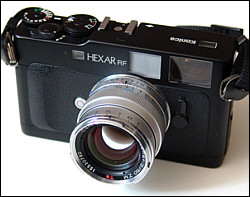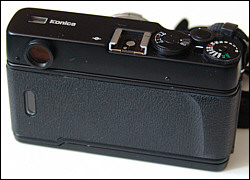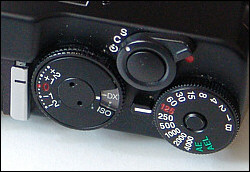Konica Hexar RF

|
|
|
| Style, film format | 35mm interchangeable lens rangefinder system |
|
|
|
| Lens, shutter | None when it arrived. Vertical metal shutter |
|
|
|
| Photo quality | Exposure system seems right on |
|
|
|
| Ergonomics | Overall, excellent |
|
|
|
I had this camera on loan for a few weeks, as it made its way to a friend in Canada.
The Hexar RF is a well-built rangefinder camera with advanced electronics, auto wind, auto rewind and a very durable body.
The camera can take M-mount lenses, including those made by Konica (of course), Leica and Zeiss. I don't have any Leica M lenses, so I can't confirm full compatibility with the entire line of Leica glass.
I can tell you that I was able to mount and use a 50mm Planar, a 25mm Biogon and a 40mm Sonnar without any problems. In the photo to the right, you can see how this camera will look better with a black-barreled lens. Chrome lenses look a bit odd on all-black bodies.
The Konica is dependent on batteries, so you should always keep a spare with you. The camera is very simple to operate. All dials and controls are where you would expect them to be. My own difficulty was in being able to set the ISO dial. The numbers are too tiny for my middle-aged eyes to focus up close in dim lighting. You can set it to DX and let the camera read it from the cartridge.

The camera features a rubberized covering with an irregular pebble surface. It feels very nice and secure in your hands. The body is just about the right size -- not too large and not too small. There is outward sweeping protrusion from the right side of the back, presumably to provide a more comfortable grip for the camera. I've never been a big fan of these, but I understand its purpose, and I'll just leave it at that. By the way, it's not as large as it appears in the photo.
On the left side of the top deck is the frame counter and battery life indicator. The back release is on the side. It's a fold-down key that you must twist. Keep in mind that if you do this while film is in the camera, it will reset the film counter to zero and then fire off two blanks.
The camera has a quick-load system. Pull out the film leader to the point indicated on the camera. Close the back. If the camera misloads, the film won't advance. There is a small window on the door to help you identify the type of film that you've loaded.
When you hold the camera, your index finger easily finds the shutter release. There is a small lever that you flip to turn the camera on. Further flips change it to continuous shooting (an advertised 2.5 frames per second) and self-timer. The self-timer light is very discreet, and you wouldn't notice it otherwise. It's a small hole just to the left of the rangefinder window, and I'm glad that Konica chose to make it like this, rather than an ugly red LED stuck on the front of the camera (Minolta XG-7 and others). It's a nice touch that the self-timer LED isn't visible except when it's activated.
I found the viewfinder to be quite good, and it's doesn't require precise eye placement. The viewfinder is nice with a clearly defined rangefinder patch and good clarity and contrast. The shutter speeds run down the left side, and at times I had difficulty seeing them. I don't wear glasses by the way. If you're beyond the range of the metering system, the slowest or fastest speed flashes.
The shutter release is somewhat of an oddity. Once you understand it, you'll have no problem. When you turn the camera on, the meter comes to life. After a period, the LEDs go out. To turn them on again, you need to depress the release but not so hard that you take a photo. I wish the camera had a more defined two-stage release. You have to teach yourself how far to depress the shutter without releasing it. The distance from meter actuation to shutter release seems too short until you get the hang of it. That said, I never accidentally took a photo while trying to metering a scene.

As with most dials on autoexposure cameras, it locks on AE and AEL. To move off either AE or AEL, you must press the button in the middle while turning the dial. Autoexposure lock involves keeping the shutter release depressed, which holds the exposure setting. I think there should have been hard harder click -- or detente -- when going from AE to AEL. While the dial is locked on AE and AEL, you can easily move between the two -- too easily, I think.
Exposure compensation can be dialed in simply. See the photo.
Some have complained that there is some shutter release lag -- that is, there is a tiny gap in time measured in milliseconds from the time you press the release until the shutter is released. In use, I found it to not be a problem. However, I should qualify this by saying that I didn't use this for any action shots, where shutter release lag is more noticeable.
Overall, I found the Hexar RF to be of excellent quality.
